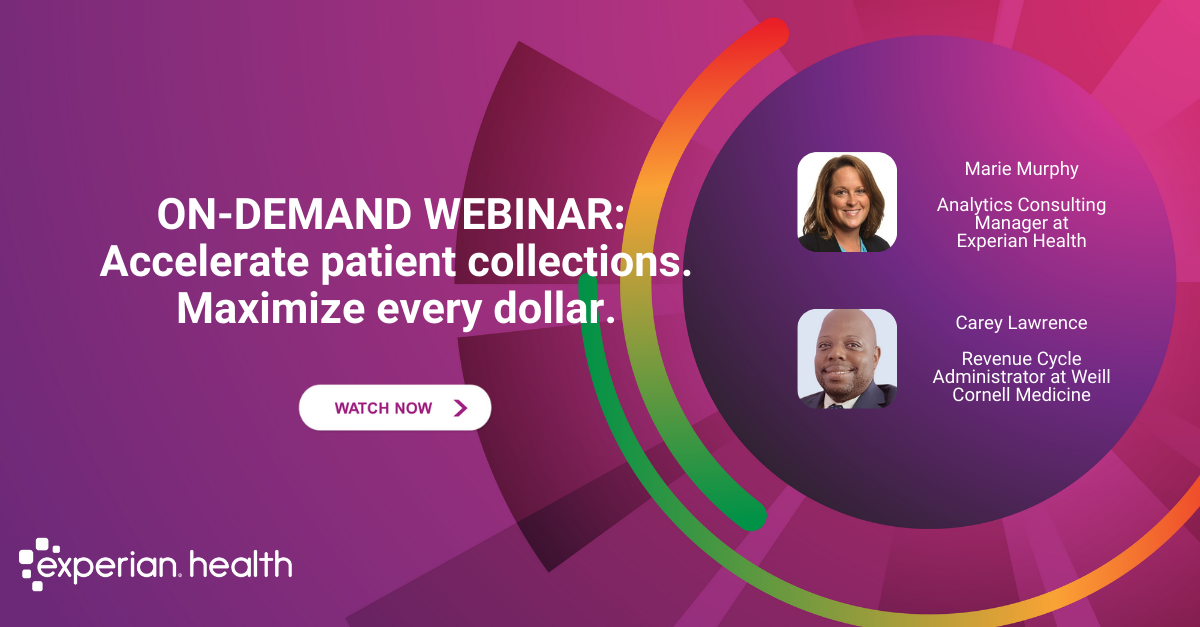
Key control:
- Medical care organizations face growing levels of uncollectible debt and a strong decrease in charges.
- The propensity to pay models that use automatic learning and robust data sacrifice the understanding of the probability of paying a patient and allow staff to focus their collection efforts where they refer.
- In 2024, Experian Health clients who implemented Collection Optimization Manager I saw a ROI 10: 1. Some clients, such as Weill Cornell Medicine, have seen up to $ 15 million in recoveries.
Medical care organizations face a strong decrease in charges and an increase in uncollectible debt. The increase in paid car costs and more patients fighting their medical bills are contributing factors. Inefficient Collections practicesThe dependency of third -party agencies that do not use propensity scores to pay and manual processes are also key taxpayers for this growing market problem. Suppliers that adopt Propensity models to pay That use data and automation to predict the probability of payment to see the recovery of improved income and patient satisfaction.
This is what you should know about the strategies of propensity collections to pay in medical care.
Why the propensity to pay matters in medical care collections
“Propensity to pay” is a data -based model that identifies populations of patients with the most probability of paying, to improve existing collection strategies. When billing equipment better includes the propensity of a patient to pay, they can easily prioritize the scope and assign effective charges. This relieves their workload, since they can focus their efforts in which they will have the greatest impact and in accounts with the greatest probability of payment. Maintaining more internal collections also reduces dependence on the expensive third -party agencies, while eliminating the waste in the repeated telephone calls of low performance or the statements sent by mail do not pay. The need to adopt models of propensity to pay has grown in recent years as patients volumes and the cost of care grow continuous.
In the last 20 years, US hospitals have almost absorbed $ 745 billion in uncompromured attention, According to the data of the American Association of the Hospital.
American Hospital Association
Increased medical care costs and the newly promulgated “A great billThey are expected to change even more financial responsibility to hospitals and patients.
Unfortunately, many organizations still trust processes of inefficient collections, third -party agencies and Medical Billing Practices That lack information to pay. The result? Interruptions in everything Income cycleIncluding the patient’s lost income, the hours of wasted resources, the increase in costs to collect and the high costs of suppliers. The use of obsolete collections strategies also contributes to the dissatisfaction and rotation of the patient, which causes equally more income leaks.
Why medical care providers need propensity analysis to pay
Limited capacity of personnel and high volumes of Paid car accounts Other challenges of compound collections for organizations that have not yet adopted propensity analysis to pay. As the collection lines crawl, suppliers can remain with cash flow problems, income losses and incobrable debt.
Ultimately, this interrupts the income cycle and affects the quality of patient care, and all the patient’s experience. By taking advantage of the propensity analysis to be paid, income cycle leaders can increase Porebilities of the Income Cycle and I will be collected efforts.

Listen while Weill Cornell Medicine and Experian Health discuss how a smarter collections strategy delivered $ 15 million in recoveries, and how he can do the same. This web seminar on request shows how to move faster, work smarter and collect more, without adding staff.
How the propensity models to pay in practice work
Models of propensity to pay patients on the screen and segment based on the payment hood. Segmented accounts receive a score of propensity to pay from 1 to 5, being 1 the greatest probability of paying, and then transferred to the appropriate reconcility channels.
Experian Health solution, Collection Optimization ManagerTake advantage of automatic learning, predictive analysis and data sources, such as credit, behavior and demography, to identify which patient accounts have the most likely to pay. It also automatically shows patient data for deceased, bankruptcy, medicaid andCharity.
Patient accounts are classified into payment groups through data -based segmentation. This allows occupational collection personnel to quickly clean the accounts receivable and put their approach where it matters most, accounts of patients with the greatest possibility of paying their invoice.
With a clear image of the financial situation of a patient, medical care organizations can Improve patient communication And increase collection efforts to maximize income. High propensity accounts can receive light tact reminders, such as less frequent invoices reminders. At the same time, alternative financial assistance, such as charity or Payment plansIt can automatically make available to patients with low propensity.
Benefits of the use of propensity models to pay
Models of propensity to pay, as Experian Healths Collection Optimization Manager Solution, sacrifice numerous benefits for organizations that strengthen the income cycle.
- Higher collections rates: The use of a propensity model to pay makes AR is more administrative, especially for high patient and volume organizations. Courtesy tools, such as Experian Healths Patient and Connect patient, Easily send the auto paid options through the voice or text message, increasing the patient participation and the creation of trust.
- Incorrect reduced debt: The propensity models to be paid help identify patients with a low probability of paying their medical invoices.
- Lower collections costs: Pursuing payments in deceased accounts, bankrupt or eligible for Medicaid or charity unleashes valuable resources. With models of propensity to pay, employed personnel can work efficiently in high performance accounts internally, reducing the amount of accounts that must go to external suppliers.
- Faster cash flow: Prioritize patients with a chance of paying early and shorten the payment cycles, which can improve the predictability of the income cycle.
Implementation of propensity analysis to pay: best practices
Medical care organizations that implement propensity analysis to pay should consider the following best practices:
- Choose the appropriate partner. Look for a technological partner, such as Experian Health, with broad data assets and health experience.
- Automize patient communication. Reduce the overload and increase collections efforts with automated patient communication strategies.
- Guarantee alignment with inherited technology. For real -time precision, choose a solution that integrates soils with existing billing and EHR systems.
- Train billing personnel. Provide comprehensive training to billing equipment and collections on propensity scores to be paid and how to communicate the payment options with empathy.
- Automate agency management. Reduce the manual workload of the remittances of the audit agency automating the reconciliation process.
- Patient accounts monitoring. Look for a solution that regularly explains the changes or updates in the ability of a patient to pay or contact information.
- Monitoring performance. Monitor the key performance indicators to adjust the collection process on time and improve the prognosis.
How Experian Health’s solutions support better collections
Changing long data collection practices is a significant investment. However, the cost of inaction is greater. Experian health Collection Optimization Manager Use models of propensity to be paid, driven by automatic learning and workflows promoted by data to help medical care providers improve patient collections. Our comprehensive drawing solution of the industry sacrifices an emarter form and faster to collect patient payments, and Experian Health’s experience consultants are there in each step of the road, as collections need changes.
Get more information about how Experian Health’s data behaviors Patient collections optimization solution Help the management of the income cycle to collect more patient balances.
The publication of how the propensity models to pay help medical care providers to improve collections appeared first in the health blog.


